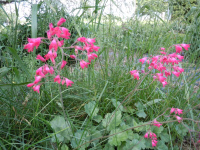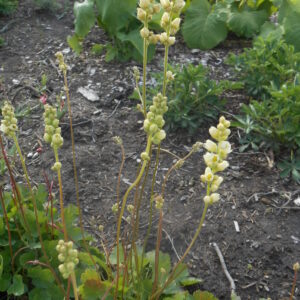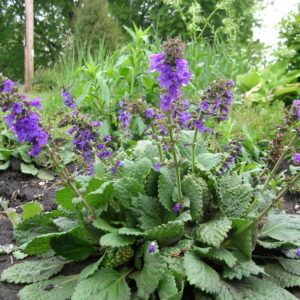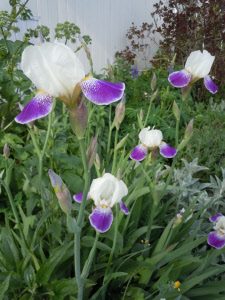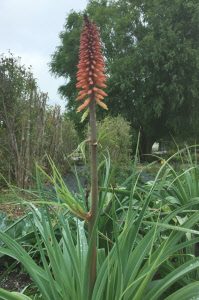Deer Resistant Plants
Showing 73–80 of 155 results
-
Hesperaloe parviflora Red Yucca Z 6-9
Cerise scarlet trumpets up and down the flower spike in summer
OUT OF STOCK
Cerise scarlet trumpets up and down the flower spike in summer
Size: 3’ x 5’
Care: sun moist well-drained to dry soil
Native: Europe, west & central Asia
Wildlife Value: Attracts butterflies & hummingbirds. Deer and rabbit tolerant,Named by Dr. George Engelmann, a German physician and plant fanatic who emigrated to America in the early 1800’s, settling in St. Louis.
-
Heuchera sanguinea Coral bells, Alumroot Z 3-8
Coral red flowers in late spring through early summer. “One of the finest hardy perennials recently introduced …bright crimson flowers…very graceful,” Farquhar Catalog, 1893.
Coral red flowers in late spring through early summer. “One of the finest hardy perennials recently introduced …bright crimson flowers…very graceful,” Farquhar Catalog, 1893.
Size: 12" x 12"
Care: sun to part shade in moist well-drained soil.
Native: Western U.S.- Rocky MountainsGenus Heuchera named for Johann Heinrich von Heucher (1677-1747) professor of medicine at Wittenburg University. This species collected Be Dr. Frederick Adolph Wislizenus in the Porphyry Mountains of Llanos Mexico on the Col. Doiphan Expedition in 1846-7. Named by Dr. George Engelmann, (1809-1884) physician and avid botanist encouraging and supporting those who explored for plants. He emigrated from Germany and settled in St. Louis. Plant popular in the 1880’s.
-
Heuchera versicolor syn. H. rubescens var. versicolor Pink alumroot Z 4-10
Tiny pink bells on narrow inflorescence blooming mid to late summer
OUT OF STOCK
Tiny pink bells on narrow inflorescence blooming mid to late summer
Size: 8-12” x 12"
Care: prefers part shade in moist well-drained to well drained soil, can grow in sun with moist soil. Deer resistant.
Native: southwestern US
Wildlife Value: attracts bees, butterflies and hummingbirdsFirst collected in 1904 on damp, shady bluffs of the Black Range in New Mexico, accd. to Edward Lee Greene.
The roots are astringent and can also be used as an alum substitute, used in fixing dyes. Was also used medicinally for fever, diarrhea, venereal disease, liver ailments, eyewash, colic and animal care. Heuchera is named for Johann Heinrich von Heucher (1677-1747), while rubescens means becoming red or reddish, and versicolor means variously colored.
-
Horminum pyrenaicum Dragonmouth, Pyrenean Dead-nettle Z 5-9
Deep purple salvia-like blooms in April to May above rosettes of wide, flat leaves
Deep purple salvia-like blooms late spring to early summer above rosettes of wide, flat leaves
Size: 8-16” x 12”
Care: Sun to part shade in moist well-drained soil. Drought tolerant.
Native: Pyrenees & Alps
Wildlife Value: Attracts bees, butterflies and birds. Deer and rabbit resistant.Before 1753, Linnaeus.
-
Iris ‘Wabash’ Z 5-8
Pure white standards with deep violet falls edged in white in late May-early June
Pure white standards with deep violet falls edged in white in late May-early June.
Size: 39" x 8"
Care: sun in moist well-drained soil.
Awards: Dykes award (best iris) winner 1940.Iris is named after the Greek goddess who accompanied the souls of women to the Elysian Fields by way of the rainbow. Her footprints left flowers the colors of the rainbow. Iris means the eye of heaven. The iris is the flower of chivalry, having “a sword for its leaf and a lily for its heart.” Hybridized by Williamson in 1936
-
Iris missouriensis Western blue flag, Rocky Mountain iris Z 3-8
In spring variegated, violet blue iris flowers - 6 perianth segments, 3 spreading to reflexed falls with a dark yellow-orange stripe down the middle with blue lines on a white background, & 3 purple standards.
OUT OF STOCK
In spring variegated, violet blue iris flowers – 6 perianth segments, 3 spreading to reflexed falls with a dark yellow-orange stripe down the middle with blue lines on a white background, & 3 purple standards.
Size: 12-24” x 9-12”
Care: sun to part shade in moist well-drained to moist soil. Divide regularly.
Native: Alberta and British Columbia, from Minnesota to Washington south to California east to New Mexico
Wildlife Value: Deer resistant. Attracts hummingbirds, provides pollen to bees.Named for the Missouri River although ironically Lewis collected it along the Blackfoot River in today’s Montana on July 5, 1806.
Paiute Indians of eastern California and southeastern Oregon made ear drops to remedy earaches with a decoction if the Iris roots. -
Iris pumila Dwarf iris Z4-8
Natural hybrid created this tiny, purple bearded iris blooming in early spring bearing year-long green-grey sword-shaped leaves. Spreads to form large, tight clumps.
Natural hybrid created this tiny, purple bearded iris blooming in early spring bearing year-long green-grey sword-shaped leaves. Spreads to form large, tight clumps.
Size: 6-8” x spreading.
Care: sun in well-drained to moist well-drained soil
Native: Eastern Europe
Wildlife Value: deer resistantIn gardens before 1753
-
Kniphofia caulescens Red hot poker, Regal torch lily Z 5-10
fat spikes of flowers open coral-red, turning pale lemon-yellow
OUT OF STOCK
Evergreen perennial with short, stout stems bearing grass-like broad, grey-green leaves. Blooming July to August, fat spikes of flowers open coral-red, turning pale lemon-yellow
Size: 3’ x 2-3’
Care: sun in moist well-drained soil
Native: Lesotho South Africa
Wildlife Value: deer and rabbit resistant. Attracts hummingbirds
Awards: Royal Horticultural Society Award of Garden Merit; Denver Botanic Garden Plant SelectIntroduced to gardens by Mr. T. Cooper about 1860. 1st described by French botanist Carrière in Revue Horticole in 1884


